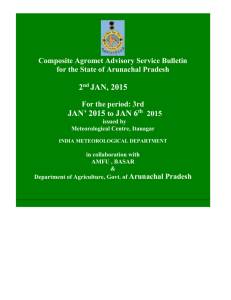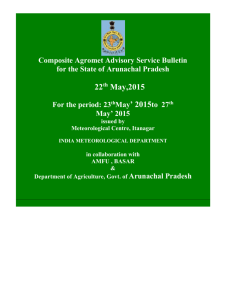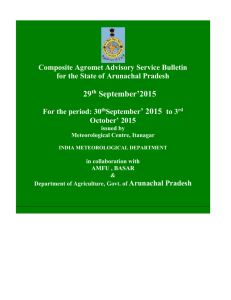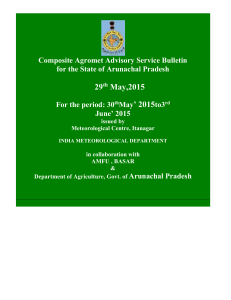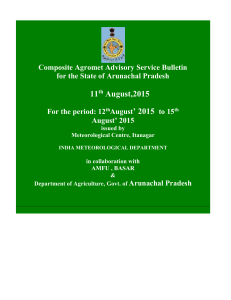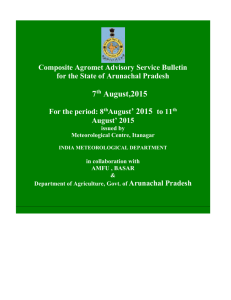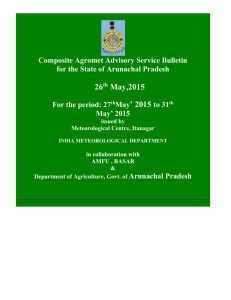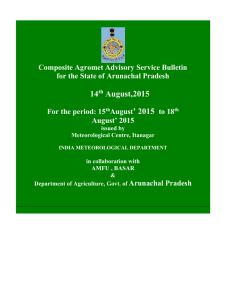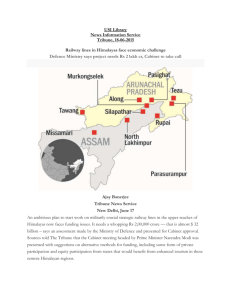Higher Education in Arunachal Pradesh: Issues and Prospects
advertisement
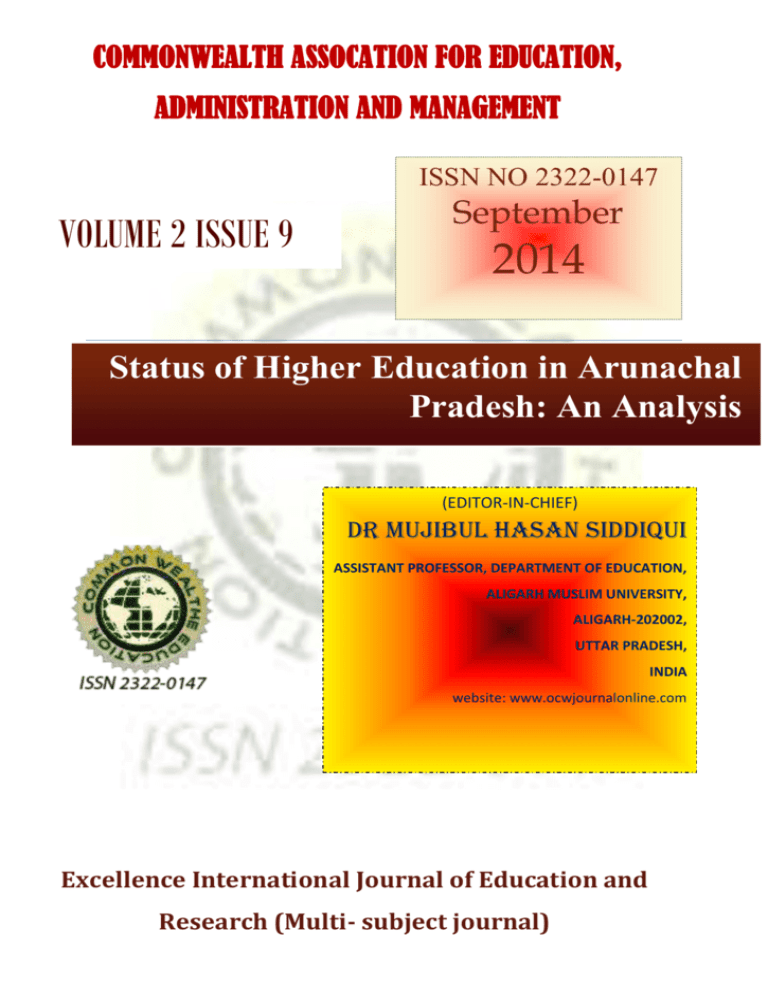
COMMONWEALTH ASSOCATION FOR EDUCATION, ADMINISTRATION AND MANAGEMENT ISSN NO 2322-0147 VOLUME 2 ISSUE 9 September 2014 Status of Higher Education in Arunachal Pradesh: An Analysis (EDITOR-IN-CHIEF) DR MUJIBUL HASAN SIDDIQUI ASSISTANT PROFESSOR, DEPARTMENT OF EDUCATION, ALIGARH MUSLIM UNIVERSITY, ALIGARH-202002, UTTAR PRADESH, INDIA website: www.ocwjournalonline.com Excellence International Journal of Education and Research (Multi- subject journal) Excellence International Journal Of Education And Research VOLUME 2 ISSUE 9 ISSN 2322-0147 Status of Higher Education in Arunachal Pradesh: An Analysis By Dr (Mrs) Kesang Degi Associate Professor Dept of Education, RGU, Rono Hills, Doimukh, Itanagar, 791112, Arunachal Pradesh, India Email Id: ml_swl@yahoo.co.in Abstract The development of a modern society depends to a large extent on its educational institutions and education system. Education System in India currently represents a great paradox. On the one hand we have IIMs & IITs that rank among the best institutes in the world and on the other hand there are number of schools and colleges in the country that don't even have the basic infrastructure facilities. This paper analyses some of the existing lacunae of higher education in the state of Arunachal Pradesh. There are numbers of issues like: quality of education, infrastructure, faculty development, examination system, curriculum, unplanned expansion etc which needs immediate attention. Keywords: Education system, higher education, expansion. Introduction Education is a basic need of every society. A better education system can enhance the social, scientific, and technological improvement of a country. It is only through education that people become aware of their rights, duties and obligation. Education helps man to grow in all dimensions, mastering and controlling emotions and will. The development of a modern society depends to a large extent on the nature and standard of higher education. Therefore, the role of higher education is to prepare competent, knowledgeable and far-sighted people for assuming various higher responsibilities. Higher education ensures better employment, higher salaries and greater ability to consume and save. Higher Education today is recognised as capital investment. Investment in education is considered investment in human capital and this increase productivity. In this era, advanced technological growth and economic development is difficult to accelerate without the participation of highly qualified manpower. Excellence International Journal Of Education And Research (Multi-subject journal) Page 286 Excellence International Journal Of Education And Research VOLUME 2 ISSUE 9 ISSN 2322-0147 India has made quantitative progress in the field of higher education post independence. The number of universities and enrolment has increased rapidly. The educational structure in India is generally referred to the 10+2+3 pattern. The first ten years provide undifferentiated general education for all students. The +2 stage, also known as the higher secondary or senior secondary, provides for differentiation into academic and vocational streams and marks the end of school education. In +3 stage, which involves college education, the student goes for higher studies in his chosen field of subject. There is a massive growth in the enrolment at +3 stage, it is almost double than PG and Research level. Education System in India currently represents a great paradox. On the one hand it has institutes like IIMs & IITs that rank among the best institutes in the world and on the other hand there are number of schools and colleges that don't even have the basic infrastructure facilities. Such is the case with the state of Arunachal Pradesh. The state of Arunachal Pradesh is located in the easternmost part of India bordering China, Bhutan and Myanmar. The literacy rate of the state according to census 2001 is 54.74%. In Arunachal Pradesh formal education started only after independence. Till 1947 there was no higher educational institution in the state. The literacy rate of the state was below 1 percent. However with the attainment of independence the new era of educational progress and development started. The development of higher education started after it was made Union Territory in 1972. Col. K.A.A. Raja laid the foundation of higher education in the state. At present there is 1 Central University, 15 Degree Colleges, 1 Horticulture College, 1 Homeopathy College, 1 Law College, 1 Institute of Science and Technology, 1 NIT and 5 College for Teacher Education in the state. There has been a rapid increase in the enrolment of students at higher level in Arunachal Pradesh but, the quality and relevance of education is serious concern. Higher education in Arunachal Pradesh is facing severe problems like, infrastructure, unplanned expansion, examination system etc. There is an urgent need to address these problems and introduce new vision in higher education. Higher education is faced with very severe challenges in the shape of various economic, social, political, and moral changes, and its future depends on the response made by its people to these challenges (Rao, 2003). Through the following few points, an attempt has been made to analyse the issues of higher education in Arunachal Pradesh: 1. Infrastructure Facilities The increase demand for higher education requires infrastructural facilities, which is the biggest problem in Arunachal Pradesh today. As mentioned earlier there are 15 degree Excellence International Journal Of Education And Research (Multi-subject journal) Page 287 Excellence International Journal Of Education And Research VOLUME 2 ISSUE 9 ISSN 2322-0147 colleges 12 government colleges and 3 privately run colleges. Most of the government colleges don’t even have permanent site to construct college buildings. Temporary arrangements are made for running classes in either rented building or in some unused government buildings. No question of library, laboratory and other facilities. The enrolment at undergraduate level is increasing every year, but the number of teachers in the colleges is very less. There are 3-4 teachers in every subject which is too less for running honours courses. Many colleges are unable to start honours courses in many subjects due to shortage of teachers and classroom facility. 2. Unplanned Expansion There is impressive growth in the number of higher education institutions in the state after independence. Before independence there was no higher educational institution in the state of Arunachal Pradesh. But, today we have good number of higher educational institution in the state. There has been an impressive quantitative expansion in the general colleges but the rate of increase in science and technology sector in not significant and the striking reality is that out of these 15 degree colleges, in 3 colleges the enrolment of students is less than 300, where as in some colleges the number is so high that, in one class there are two- three sections and one section consists of more than 100 students. The situation is alarming shocking. There is a great need for planning before opening a new college. No doubt, there is high demand of higher institution in the state, but government has to first identify the locations, accessibility and population of the area/district before establishing colleges. 3. Students Unrest Most students with backgrounds in arts, humanities, and law get actively involve in political activities. Students are more in system of linking political parties with their student wing. They are one of the most powerful and influential group in the state, they have free access with the highest political leaders. There is free flow of money in student politics. 4. Examination System There are number of literature in India which indicates that the present system of evaluation is not appropriate. In Arunachal Pradesh at degree level, there is annual system of examination. The one time evaluation and absence of internal assessment has series of Excellence International Journal Of Education And Research (Multi-subject journal) Page 288 Excellence International Journal Of Education And Research VOLUME 2 ISSUE 9 ISSN 2322-0147 drawbacks. It lacks objectivity. Therefore, this issue needs to be immediately addressee to provide quality education. 5. Unemployment The college of the state today is producing thousands of unemployed graduates every year. (Mohanthy, 2000) found that “There is a marked mismatch in terms of the field and specialization of graduates and the absorptive capacity of the labour market.” In Arunachal Pradesh most of the students are first generation learners generally from rural area. Therefore, the biggest challenge for the faculty would be to prepare Teaching – Learning materials. But unfortunately, due to time constraints teachers are running after completion of their courses which results our students misfit in industrial world. Question is how to make higher education relevant? At present students have very little choice in combinations to choose subjects. Providing a variety of subjects to choose will make learning more interesting and meaningful. Apart from that, different courses should be introduced so that students coming out of the institution will become more employable or self employable. Courses like Computer Science and Business Management in which employment opportunities are abundant should introduce in degree colleges. 6. Faculty Teachers play a major role in educational service of a college. Quality of education depends upto many extend on the aptitude, efficiency and interest of teaching faculty. Teachers need constant latest knowledge in their discipline and other related areas. Reading of books articles, paper presentation and publication is necessary for the teachers. Opportunities must be provided to the teaching faculty to attend seminars and conferences. But in Arunachal Pradesh, teachers are overburdened. The number of present faculty is very small when compared to other states of the country. The quality of education is another issue as many present faculty members are teaching courses which are not their own specialization. Also the teachers have very limited opportunity because of reasons like: first, there is no environment in the college for research activities, second because of lack of financing as state government is not in a position to bear expenses for attending seminar of all college teacher, finally time constraint, teachers are busy finishing their courses as banned calls and other students activities are very common in the state which often suspend classes. Excellence International Journal Of Education And Research (Multi-subject journal) Page 289 Excellence International Journal Of Education And Research VOLUME 2 ISSUE 9 ISSN 2322-0147 Conclusion Higher education plays important role for national development. It provides opportunity to reflect on social, economic, cultural and moral issues facing humanity. There are many issue of higher education in Arunachal Pradesh like- infrastructure, examination, unemployment etc. which needs to be addressed immediately. Bayli (1987) studied that “The condition of higher education in universities and colleges is not satisfactory in the eyes of students. Lack of physical and educational facilities is bringing much hindrance in the way of development”. A change is needed in examination system and the courses offered in the colleges. More job oriented subjects needs to be included in the curriculum and proper planning is important to impart quality education. Finally, it is suggested that teachers must be motivated to involve in more research activities to update their knowledge. References Bayli, J. (1987), Problems of higher education in the Third World. New Delhi, India: Best, J. W. (1994), Research in education. New Delhi, India: Prentice-Hall Government of Arunachal Pradesh, educational Statistical Survey 2009 & 2010 Haider, S. Z. (2008), Challenges in Higher Education: Special reference to Pakistan and South Asian Developing Countries: Non Partisan Education Review Vol. 4, No.2, Pakistan Retrieved on 10.10.2012 Jeyraj, N. (1998). Higher Education, Vision and Mission for Twenty- First Century. Lady Doak College, Madurai. . Mobasser, M, (2007), Higher Education in Bangladesh: Status, Issues and Prospects (A paper presented in the international conference on “Knowledge for Development: Assessing the Capacity, Quality and Relevance of Universities in Asia” held in Colombo, Sri Lanka- 25th of January’2007) Retrieved on 10.10.2012 Mohanty, J. (2000), Current trends in Higher Education, Deep & Deep Publications, New Delhi Rao, V. K. (2003), Higher education. New Delhi, India: A. P. H. Public Corporation. Excellence International Journal Of Education And Research (Multi-subject journal) Page 290
